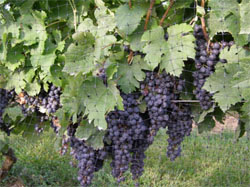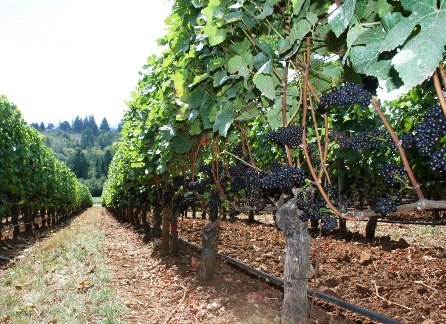Practices Other Considerations More information
Mark Chien, Pennsylvania State University and Patty Skinkis, Oregon State University
In any given growing season, there are no two management techniques that can affect the outcome of grape quality more than proper canopy and fruit zone crop management. While another article covers canopy management, this article focuses specifically on fruit zone management.
Canopy management is the first step to fruit zone management
Canopy management begins even before the vineyard is planted, as it is critical to select the best suited varieties, clones and rootstocks for the given climate and site. Site characteristics are also important, as these, combined with rootstocks and clones, will influence crop quantity and quality. Deep, fertile soils are known to produce larger vines with the ability to carry higher yields; however, well-drained or shallow soils will result in smaller, weaker vines with lower yields. Vineyard design, training system, and vine x row spacing will affect a vine’s canopy size and fruit yield capacity, and as a result will play a role in how the fruit zone is managed.
Fruit zone management practices
Fruit zone management encompasses those practices that affect the cluster-zone microclimate, including manipulation of canopy density, cluster thinning and basal leaf removal. These practices are important for disease control, ripening, and production of color and flavor compounds in the fruit. Opening up the cluster zone reduces humidity, and increases temperature and sunlight exposure, which can reduce disease infection of fruit and enhance fruit quality production. However, the fruit zone management techniques to use in a given vineyard depend on vine vigor status, other management practices, and regional climate.
Crop thinning and cluster positioning. It is common in winegrape production to restrict the crop levels through crop thinning practices. The amount of crop is determined by the type, style, and price point of the wine for which the grapes are intended. The job of the viticulturist is to set the proper crop size to ensure the fruit will reach optimum maturity. See Crop Thinning for a thorough discussion of the topic.
The second technique in managing the cluster zone is “cluster positioning.” This is very important to both disease reduction and fruit ripening. It begins with proper pruning, especially the placement of spurs. While pruning for production is always an important goal, pruning for position is just as important. Equal distribution of clusters throughout the fruit zone is ideal. Certainly no clusters should be touching. If they are, then shoot crowding is probably also a problem and canopy balance needs to be assessed. Visually, all of the fruit should be in a narrow band, equidistant from the fruiting wire, depending on whether it is the basal or apical cluster. Low final yields per vine in wine production are often a result of fruit zone management, which involves reduced shoot density (fewer shoots/vine, fewer shoots/spur, or fewer spurs) and cluster positioning. Using these practices reduces yield by removal of fruitful shoots or clusters. Not all grape growing regions will require the same amount of cluster thinning. The level of crop and canopy manipulation to produce quality fruit depends on the region’s disease pressures, climate (sun/heat), and growing season length.
The photos above serve as examples of cluster thinning and positioning in the fruit zone. The photo on the left has overlapping fruit and has not been thinned. The photo on the right has good cluster positioning after cluster thinning. Photos by Mark Chien, Penn State University.
Crop estimation is a vital step in cluster thinning. It is conducted during the growing season to measure accurately the amount of yield on the vine and to make decisions on crop thinning based on the vine’s ability to ripen fruit adequately. This practice can be conducted early in the season, during fruit set, but is more often practiced during the lag phase, a phase when the berries have reached approximately 50 percent of their final weight. Weights of clusters are gathered and recorded and multiplied by an increase factor. This increase factor is determined by vineyard records comparing lag phase weights to final yields at harvest.
Basal leaf removal in and around the fruit zone is where canopy and crop management practices merge. It is important to use the appropriate timing and intensity of basal leaf removal or “leaf pulling” to get the most benefit on fruit development and ripening. As a general rule of thumb, leaf pulling should be conducted well in advance of veraison to prevent sunburned fruit. If leaf pulling is conducted post-veraison, the berries can be damaged more readily by sun/heat exposure. In cool climates, leaf pulling is often conducted on the morning-sun side of the vines and not conducted on the afternoon-sun side. In some cases, earlier leaf pulling in cool climates is conducted on both sides of the canopy cluster zone. In warmer climates, leaf pulling may not be widely practiced for fear of over exposure of fruit, and shading practices may be used.
Other Considerations
Fruit zone management will depend on several vineyard design and management factors. Certain training systems will make fruit zone management less complicated or will not require many modifications in comparison to other systems. For example, Geneva Double Curtain or hanging high-wire systems often do not require leaf pulling, since the cluster zone is at the top of the canopy and often highly exposed. Vineyard row orientation will dictate what side of the vine to pull leaves. In some warm climate grape production regions, leaf pulling is avoided, and the fruit zone is shaded by shoot positioning.
Regarding cold hardiness, most practices conducted in the vineyard to promote optimum fruit maturity, mainly the nurturing of a well-balanced and healthy vine, will also promote vine acclimation and maximum cold hardiness for the dormant period. One of the goals in a cool or cold climate region is to get the fruit ripe and off the vine before the first fall frost, birds, deer or other harvest threats. These detrimental factors can reduce the viability of the canopy in providing for adequate winter hardiness and the increased carbon and mineral nutrient gain that should occur post-harvest. Crop thinning may be a key factor to enhance ripening and vine hardiness in some climates. Once the fruit is harvested, the vine can devote canopy resources to hardening off for the winter.
Canopy and fruit zone management are key factors in managing winegrape vineyards. In many cases, some of these practices are still conducted by manual labor and are very time consuming and costly. Some practices are conducted mechanically, particularly leaf pulling; however, crop thinning and positioning is still largely conducted with manual labor. Since these practices come at a considerable cost in manual and machine labor, extensive use is only possible in vineyards that produce for higher price-point wines.
Recommended Resources
Kliewer, W.M. and N.K. Dokoozlian. 2005. Leaf Area/Crop Weight Ratios of Grapevines: Influence on Fruit Composition and Wine Quality. American Journal of Enoogy and Viticulture 56: 1700-181.
Smart, Richard and Mike Robinson. 1991. Sunlight into Wine: A Handbook for Wine Grape Canopy Management. Winetitles.
Wolf, Tony. Wine Grape Production Guide for Eastern North America. 2008. Natural Resource, Agriculture, and Engineering Service.
Hellman, Edward W. Oregon Viticulture. 2003. Oregon State University Press.
Crop Thinning in Cool Climate Vineyards video, Oregon State University
Canopy and fruit zone management, Pennsylvania State University
Reviewed by Patty Skinkis, Oregon State University
and Eric Stafne, Mississippi State University




